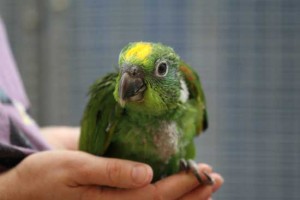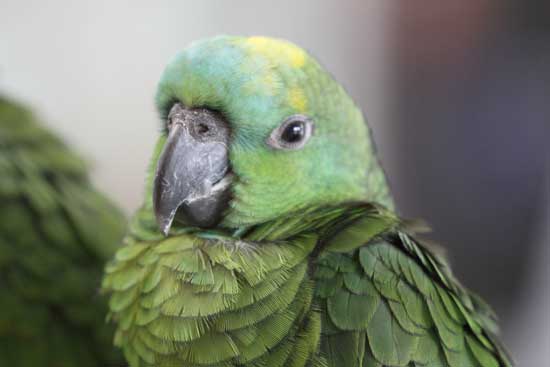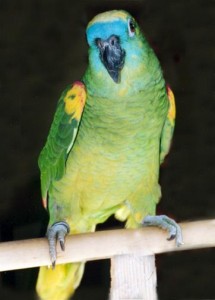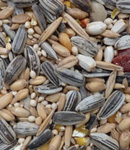Amazon care guide
Blue Fronted Amazons make great pet for people with the time and love to share. They are highly intelligent birds with bright personalities and an amazing talking abilities. They are quite playful, but they are not as cuddly as other species of parrot.
Longevity
The life span of yellow crown amazons is 50-60 years or more. They possibly live longer in captivity when provided with good nutrition and a proper environment.
Availability at Birdsville
If you are interested in owning one of these beautiful birds call us or visit us for a chat at Birdsville. Amazon parrots are seasonal which means they do not breed in the colder months. We sell our birds fully weaned if we do not have a baby available we can place you on the waiting list to be next in line.
Blue Fronted Amazon Distribution and Habitat
The Blue Fronted Amazon natural occur in rainforest to open Savannah in North-eastern Bolivia, South-Western Mato Grosso, Brazil, Paraguay, Northern Argentina and Northernmost Buenos Aires.
They can also be found in a small feral breeding population in Stuttgart, South-western Germany.
Description and Life Span
These birds are mainly green parrot about 38 cm long with blue feathers on the forehead above the beak and yellow on the face and crown with a mostly black beak. Not all amazon parrots are the same and all have varying amounts of blue and yellow on the face. There is no overt sexual dimorphism. Adults have yellow eyes and juveniles are duller and have dark irises.
They are long lived parrots and live up to 65 years
Diet for Tame Amazons
The Blue Fronted Amazon’s diet should consist of a combination of fruits, vegetables, seeds and pellets. Bowl one, a good quality seed mix should be offered along with mung beans, safflower, wheat, oats and buckwheat. Bowl two, pellet should be offered (pellets available at Birdsville). Bowl three, fruit and veg such as apple, pear, peas, grapes, rock melon, carrot, broccoli, sweet potato, corn, chili, capsicum, stone fruit, green beans just to name a few. Fruit and veg shouldn’t be allowed to go off in the cage. Bowl four, water. Water should be cleaned out daily.
Pellets recommended- vetafarm south american mix, vetafarm pellets, Murphy’s pellets, oretty bird pellets
feed mix- Tropimix is also a great mix with pellets seeds nuts and fruits, if you own pellets amazon parrots this mix is worth a try as part of the diet.
As a treat Amazons favour nuts and sunflower seed, but only as a treat as Amazons are on a see food diet, they see food and eat it and can easily become over weight.
Always avoid avocado, lettuce, caffeine and onion. These can kill or make your bird very sick.
Tip: Always feeds your bird a quality seed mix. Quality seed mixes might be more expensive, but it can be a better value because less of the bag’s volume is made up of filler seeds that few birds will eat. It will also keep your bird in better health. It is recommended that you buy good quality seed from a pet shop or produce store, not from the supermarkets. I can not stress enough, how important buying quality seed is.
All too often i come across birds which do not look as healthy as they should and i observe there feed dishes and its obvious. I find it crazy that people will spend close to $2000 on a bird and then feed then go home and feed them a nasty cheap feed mix. Please people feed your bird the proper feed mix i have had to stress this important fact until i am blue in the face.
Housing or cages for Blue front amazon parrots
The Blue Fronted Amazon is a very active parrot, they require signification space to move around their cage and stretch their wings, as well as plenty of toys to play with, space for food and water bowls, perches and swings. All this should be keep in mind when selecting a cage, the key rule to remember, that bigger is always better.
The cage must have a metal grate above substrate to stop contamination of old food and dropping. The wiring on the cage, need to be strong as they have powerful beaks.
Perches should be rotate from time to time, to avoid repetitive stress of a single perch. Perches should be on different thickness.
Toys and swings for Amazon parrots
Blue Fronted Amazons are very active, intelligent birds, so it is important to provided them with toys to simulate their minds and avoid boredom. Select toys such as swing, natural sissal rope, wooden, acrylic and leather. Birdsville has a huge variety of toys in store suitable for amazon parrots. Swings are important for these bird’s when in captivity as it provides exercise as they use muscle’s they normally wouldnt use on a still perch.
Toys are used as a form of environmental enrichment but enrichment shouldn’t stop there. As an ex zoo keeper it was a major concern that all animals must have a variety environmental enrichment to keep the critters entertained. This is in no way different for anyone who has a tame parrot at home. Enrichment is important because parrots simply can not thrive with only perches, food and water. The fact is birds provided with enrichment are unlikely to develop psychological problems such as self mutilation, feather plucking and excessive squawking. Enrichment WILL in fact effect your bird in a positive way with its mental and physical development when training your bird you will actually end up with a better, less fearful, friendlier and relaxed bird which will be more easily trained. Enrichment can be chew toys, play toys, leather toys, acrylic plastic toys, wooden toys, shredding toys, ropes, swings, ladders, bells, balls, birdie balls, plain card board,small boxes, wicker baskets, tray of wheat grass, plants, bird baths,different foods, food kababs, nuts, (all available at Birdsville) You may also find in your local area pine cones, hide food inside pine cones, twigs, bendy branches, flowers and branches- safe flowers are bottle brush, grevellia, eucalypt melaleuca flowers, hubiscus, marygolds, dandy lions leaves and all, roses, violets to name a few.
Note anything found outside should be disinfected and non poisonous and toys must be non toxic.
Enrichment tip- the trick to keeping them entertained is regularly rotating toys as they will become bored with the same toy in there cage day after day. Changing them regularly will create interest for your bird as if they are receiving a whole new toy to play with.

Lice & Mites
These are the two most common parasites of cage birds and their environment, but are easily controlled with a Mite and Lice spray, available at Birdsville. When using spray, spray bird, entire cage, perches, nesting box and toys, remember to remove all water and feed and avoid spraying in birds’ eyes. Your bird Lice and mite bottle will explain how to use, remember avoid the mouth and eyes.
A few weeks to two months after taking your bird home, it will need to be wormed (check with the staff from Birdsville, when purchasing). Young birds that have been recently weaned have a delicate bacteria’s developing in there gut, worming at this stage could harm the bacteria’s development and your new bird. Worming will need to be done
every 6 month. Worming your bird is essential for the health of all parrots in captivity.
This is an important factor of having a well behaved hand raised bird. The bird need to be handled in a quiet, relaxed situation. Spending time with your bird while watching TV or reading is perfect, but don’t over stress your bird in the first few weeks of taking it home babies need rest. The more time you spend with your bird, the better your bird will become.
Frequently Asked Questions about Blue Fronted Amazons
Q. Why do I need to put my Amazon in a cage?
A. Your bird needs an area that is his, if you are not there and your bird is free to roam the house they can destroy your home and even electrocute them self chewing on power cords
Q. Do I feed my bird seed or pellets
A. Both a varied diet is much better and healthier for your bird.




